I’ve been working in curriculum-driven makerspaces for the past three years, where I’ve had the opportunity to mentor students of various age groups and
backgrounds on a variety of hands-on projects.
My role typically involves guiding them from the brainstorming stage all the way to building a functional prototype.
In some cases, the project is deeply embedded in the curriculum — students scout real-world problems, conduct user interviews,
propose theoretical solutions, and create rough mockups using paper, sticky notes, and charts before developing a prototype.
In other cases, the project is the culmination of their learning journey — after exploring the basics of CAD, electronics, IoT, soldering,
3D printing, laser cutting, and working with hand and power tools.
Given the diverse backgrounds of students and varying project timelines, I help bring their ideas to life by guiding them in building
practical, working prototypes.
The projects featured here were developed by students from various institutions and are presented solely to highlight my mentorship in the
areas of electronics and programming. All rights to the projects are retained by the respective students and their institutions.
Here are some highlights from the projects I've mentored:
Digital Rolling Dice
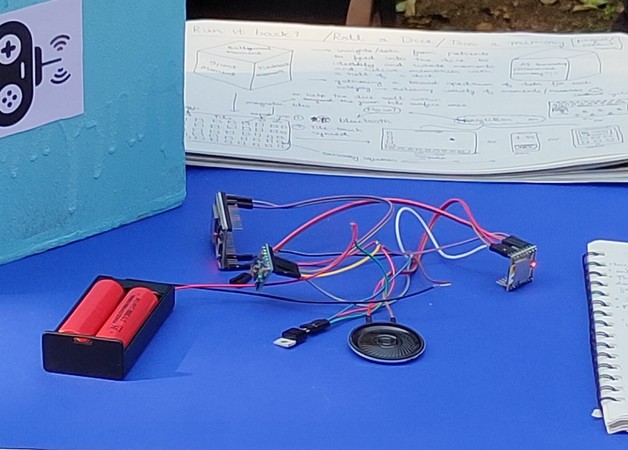
Problem Statement: Wanting to make a Digital Rolling Dice. Each face of the dice has a topic assigned. Based on the side of the
dice facing up, it will narate the story behind the topic.
Proposed Solution: Use a gyroscope-accelerometer module to detect the orientation of dice(input) and use an audio playback
module(output) to play the audio based on the orientation of the cube.
My Role: I helped the students during these stages:
⇢ Selection of the exact components for the project.
⇢ Figuring out the connection for each component with the microcontroller.
⇢ Interface the component individually with the microcontroller.
⇢ Finalize the layman logic on how the project should work.
⇢ Translate the layman logic into programming.
Tech Stack / Components: ESP32, MPU6050, DFPlayer mini, SD card, 0.5W trumpet, 3.7v 18650 li-po battery, 2x 18650 battery
case, LM7805.
Outcome: Working proof-of-concept of a device that plays assigned tune based on the side of the dice facing up.
This project was developed by B.Des (Undergraduate Design) students at
FLAME University
and is presented solely to showcase my mentorship in the area of
electronics. All rights to the project are retained by the students and the university
Transcription Device
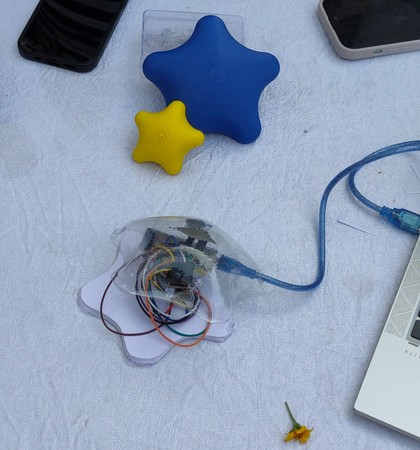
Problem Statement: Save and record trasnscription. A device carried by children to the school, it will record all the
conversation/lessons from school, convert audio to text. It will also give the short summary of the transcribed text.
Proposed Solution: Use a microphone module(input) to capture audio. Use a microcontroller with wifi capabilities to process the
audio and print the transcription onto serial monitor(output).
My Role: I helped the students during these stages:
⇢ Suggestion to explore different analog and digital mic.
⇢ Selection of the microcontroller for the project.
⇢ Figuring out the connection for the mic with the microcontroller.
⇢ Interface the component individually with the microcontroller.
Tech Stack / Components: INMP441 I2S mic, ESP32.
Outcome: Working proof-of-concept of a device that converts speech to text.
This project was developed by B.Des (Undergraduate Design) students at
FLAME University
and is presented solely to showcase my mentorship in the area of
electronics. All rights to the project are retained by the students and the university
Electric Maze
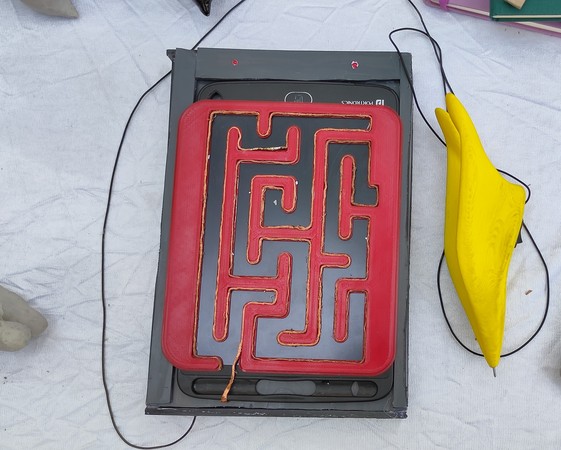
Problem Statement: Build an electrical maze for the people with Parkinson disease for them to play and practice to
stabilie their hands.
Proposed Solution: Use a simple switch connection where the tip of the pen and maze would work as two pole of the switch. When
the tip of the pen and maze comes in contact with each other(input), it will complete the circuit and light up the LED(output).
A vibration motor in the pen just for replicating
the feeling of Parkinson disease.
My Role: I helped the students during these stages:
⇢ Selection of the exact components for the project.
⇢ Use the component individually.
⇢ Finalize the layman logic on how the project should work.
⇢ Figuring out the connection of the component with each other.
Tech Stack / Components: Coin vibration motor, SPDT switch, 9V battery, LM7805, 5mm LEDs.
Outcome: Working proof-of-concept of a circuit where the vibration motors inside the pen turns on with the SPDT switch and
the LEDs turns on if the tip of the pen touches with the maze.
This project was developed by B.Des(Undergraduate Design) students at
FLAME University
and is presented solely to showcase my mentorship in the area of
electronics. All rights to the project are retained by the students and the university
Object detection
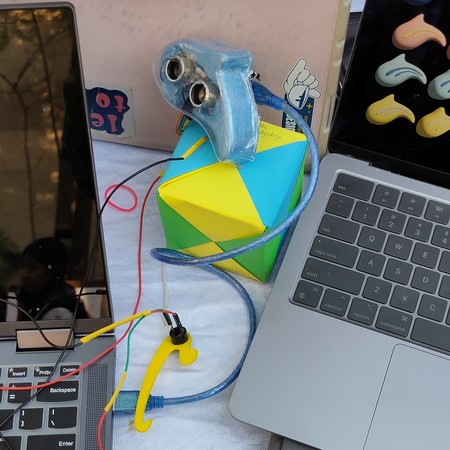
Problem Statement: A device to aid blind person by alerting them if they are approaching ay object.
Proposed Solution: Use and ultrasonic sensor to detect the object(input) and a buzzer or vibration motor(output) to alert
them.
My Role: I helped the students during these stages:
⇢ Selection of the exact components for the project.
⇢ Figuring out the connection for each component with the microcontroller.
⇢ Interface the component individually with the microcontroller.
⇢ Finalize the layman logic on how the project should work.
⇢ Translate the layman logic into programming.
Tech Stack / Components: HCSR04, Active buzzer 5v, Arduino Nano.
Outcome: Working proof-of-concept of a device that alerts the person through buzzer when an the person gets too close to an
object.
This project was developed by B.Des(Undergraduate Design) students at
FLAME University
and is presented solely to showcase my mentorship in the area of
electronics. All rights to the project are retained by the students and the university
Remote Nudging

Problem Statement: Nudging the students from distance. Device for teachers working with kids with hearing disability.
Teacher can nudge the student from distance without going near them through a remote.
Proposed Solution: Use an IR Recever module(input) that would receive the signal from the remote. Use LEDs, Buzzer or
Vibration motor(output) to alert the student.
My Role: I helped the students during these stages:
⇢ Selection of the exact components for the project.
⇢ Figuring out the connection for each component with the microcontroller.
⇢ Interface the component individually with the microcontroller.
⇢ Finalize the layman logic on how the project should work.
⇢ Translate the layman logic into programming.
Tech Stack / Components: IR Receiver module with remote, coin vibration motor, IRFZ44N MOSFET, Resistors, ESP32.
Outcome: Working proof-of-concept of a circuit which alerts when it receives specific signal from the IR remote.
This project was developed by B.Des(Undergraduate Design) students at
FLAME University
and is presented solely to showcase my mentorship in the area of
electronics. All rights to the project are retained by the students and the university
Paw soothing
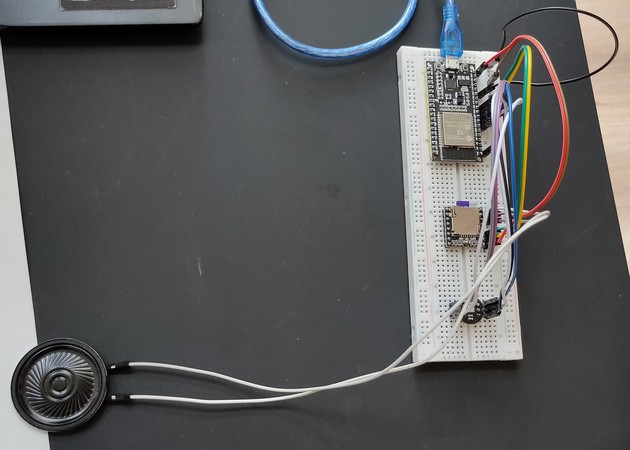
Problem Statement: Soothing animals through music therapy when the noise level crosses a threshold.
Proposed Solution: Use a digital mic to capture the noise level(input) and an audio playback module(output) to
play the audio based on the threshold set.
My Role: I helped the students during these stages:
⇢ Selection of the exact components for the project.
⇢ Figuring out the connection for each component with the microcontroller.
⇢ Interface the component individually with the microcontroller.
⇢ Finalize the layman logic on how the project should work.
⇢ Translate the layman logic into programming.
Tech Stack / Components: INMP441 I2S mic, DF Player mini, SD card, 0.5W trumpet, ESP32.
Outcome: Working proof-of-concept of a circuit that plays music when the noise level crosses a certain threshold.
This project was developed by B.Des(Undergraduate Design) students at
FLAME University
and is presented solely to showcase my mentorship in the area of
electronics. All rights to the project are retained by the students and the university
Anxiety Relief
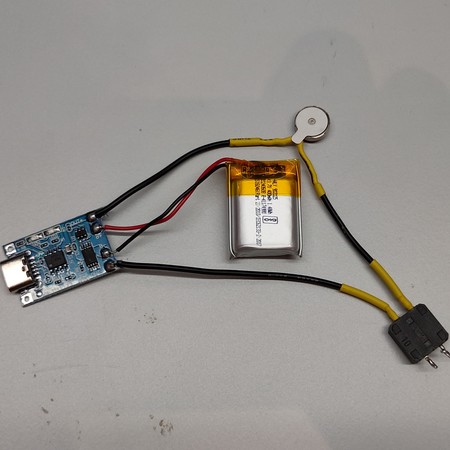
Problem Statement: Soothing humans through vibration therapy to relieve from anxiety.
Proposed Solution: Use a coin vibration motor triggered by a push button and power by a battery.
My Role: I helped the students during these stages:
⇢ Selection of the exact components for the project.
⇢ Use the component individually.
⇢ Finalize the layman logic on how the project should work.
⇢ Figuring out the connection of the component with each other.
Tech Stack / Components: Coin vibation motor, 3.7v single cell li-on battery, TP4056 BMS, Push button.
Outcome: Working proof-of-concept of a circuit that vibrates when the push button is pressed with the abiity to recharge
the battery.
This project was developed by CS(Undergraduate) students at
FLAME University
and is presented solely to showcase my mentorship in the area of
electronics. All rights to the project are retained by the students and the university
Touch to Play
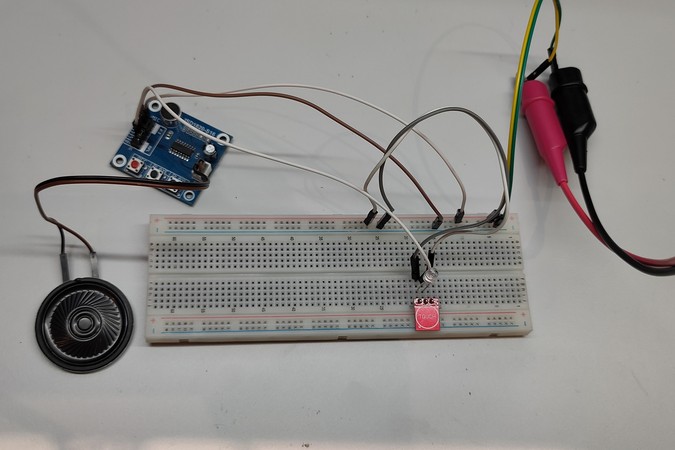
Problem Statement: Make the toy animal play it's sound when you pet certain part of the body. Want to make multiple of it,
so components can't be expensive.
Proposed Solution: Use a capacitive sensor(input) to detect the pet and ISD1820(output) to pre-record and play the sound of
animal .
My Role: I helped the faculty during these stages:
⇢ Selection of the exact components for the project.
⇢ Use the component individually.
⇢ Finalize the layman logic on how the project should work.
⇢ Figuring out the connection of the component with each other.
Tech Stack / Components: TTP223 touch key module, ISD1820 voice record and playback module, LED 5mm, 3.7v 18650 li-po
battery.
Outcome: Working proof-of-concept of a circuit that plays pre-recorded audio when touch key module is touched. A
micro-controllerless setup.
This project was developed for the faculty at
FLAME University
and is presented solely to showcase my mentorship in the area of
electronics. All rights to the project are retained by the students and the university
Smart Bowling Pitch
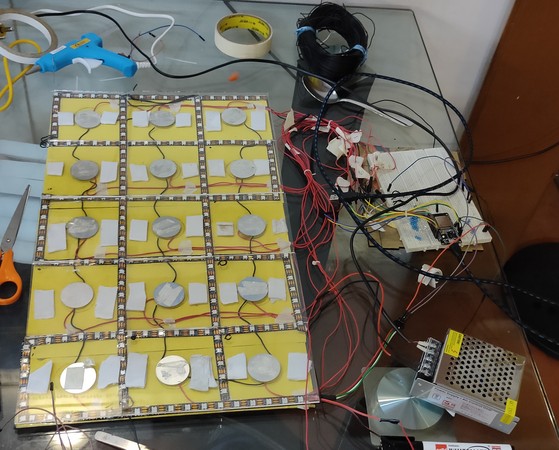
Problem Statement: Make a smart bowling pitch. Bowler can use for prcticing and improving bowling. Set a target on the
pitch where the bowl should bounce. Light up the tile where bowl actually bounced.
Proposed Solution: Explore Piezo electric disk and Step response(input) to see which one is better and efficient to detect
bounce of bowl, addressable LED strip(output) to light up the tile and a microcontroller with Wifi capability to send instructin or
receive data.
My Role: I helped the students during these stages:
⇢ Selection of the exact components for the project.
⇢ Figuring out the connection for each component with the microcontroller.
⇢ Interface the component individually with the microcontroller.
⇢ Finalize the layman logic on how the project should work.
⇢ Translate the layman logic into programming.
Tech Stack / Components: Piezoelectric ceramic disk 35mm, WS2812B LED strip, 5V5A SMPS, Resistors, ESP32.
Outcome: Working prototype of bowling pitch that can lit up the targeted tile with bue color, if the ball bounces on the
targeted tile then lit the tile green and if the ball bounces on different tile, lit it red.
This project was developed by talents(Higher Secondary) from Innovation school at
Maker's Asylum
and is presented solely to showcase my mentorship in the area of
electronics. All rights to the project are retained by the talents and the institution
Sign Language to Text
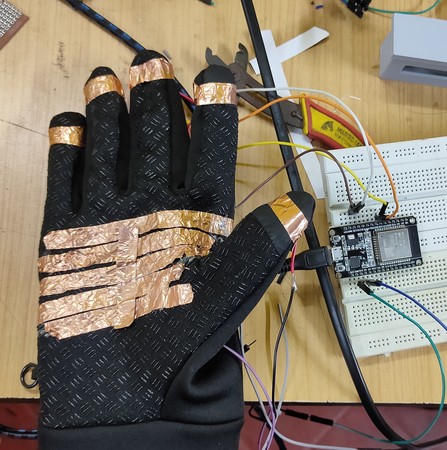
Problem Statement: Bridge the gap between the deaf and hearing people. A smart wearable wearable glove which can
translate the sign language into texts.
Proposed Solution: Explore flex sensor and simple copper tape on each finger, thumb and palm(input) connected to
digital pin of microcontroler to see
which one works best interpreting the sign language and print the output in the serial monitor(output).
My Role: I helped the students during these stages:
⇢ Selection of the exact components for the project.
⇢ Figuring out the connection for each component with the microcontroller.
⇢ Interface the component individually with the microcontroller.
⇢ Finalize the layman logic on how the project should work.
⇢ Translate the layman logic into programming.
Tech Stack / Components: Copper tape, ESP32.
Outcome: Working proof-of-concept of a glove where you make a sign language, combination of copper tapes come in contact.
Based on the combination, a letter is detected, like if 4 fingers are in contact with the palm and thumb is not in contact, its an A .
This project was developed by talents(Higher Secondary) from Innovation school at
Maker's Asylum
and is presented solely to showcase my mentorship in the area of
electronics. All rights to the project are retained by the talents and the institution
Cocktail Maker
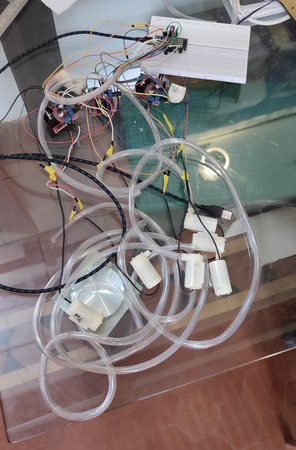
Problem Statement: A bot that makes cocktails.
Proposed Solution: Use DC submersible water pump with a driver(output) to siphon liquid and microcontroller like
EPS32 to send the selection of drink through serial monitor(input).
My Role: I helped the students during these stages:
⇢ Selection of the exact components for the project.
⇢ Figuring out the connection for each component with the microcontroller.
⇢ Interface the component individually with the microcontroller.
⇢ Finalize the layman logic on how the project should work.
⇢ Translate the layman logic into programming.
Tech Stack / Components: DC submersible water pump, L298N driver, ESP32, 12V3A adaptor
Outcome: Working prototype of a bot that makes cocktail. Each motor is dipped inside a vessel with pulp and liquid. When the
command to make a specific drink is sent through serial monitor, it mixes fix proportion of liquid from different vessel to make the
cocktail.
This project was developed by talents(Higher Secondary) from Innovation school at
Maker's Asylum
and is presented solely to showcase my mentorship in the area of
electronics. All rights to the project are retained by the talents and the institution
Heart Rate Monitor

Problem Statement: A device which monitors the heartrate and alerts the user when the heart rate crosses a certain
threshold.
Proposed Solution: A heart rate sensor(input) to monitor the heart rate. LED ring and OLED display(output) to alert the user.
A tiny microcontroller with wifi capabilities, since it is a wearable device. Battery and BMS + Booster for power supply.
My Role: I helped the students during these stages:
⇢ Selection of the exact components for the project.
⇢ Figuring out the connection for each component with the microcontroller.
⇢ Interface the component individually with the microcontroller.
⇢ Finalize the layman logic on how the project should work.
⇢ Translate the layman logic into programming.
Tech Stack / Components: MAX30102 heart rate sensor, 8bit WS2812 RGB ring, 0.96" OLED, 3.7V single cell li-on battery,
TP4056 18650 BMS + Booster, coin vibration motor, Xiao ESP32C3.
Outcome: Working prototype of a device which monitors heart rate. Shows the average BPM on the OLED. If the heart rate crosses
a certain threshold, the ring LED turns red and vibration motor turns on.
This project was developed by talents(Higher Secondary) from Innovation school at
Maker's Asylum
and is presented solely to showcase my mentorship in the area of
electronics. All rights to the project are retained by the talents and the institution
Bone Conduction
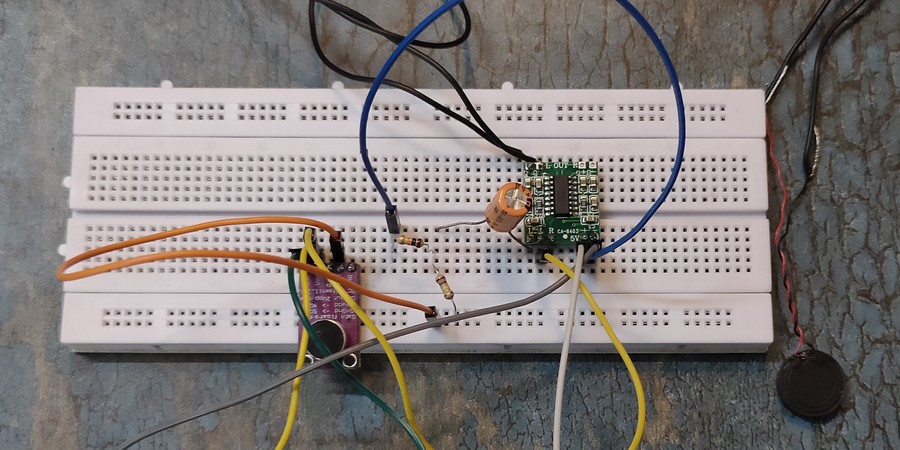
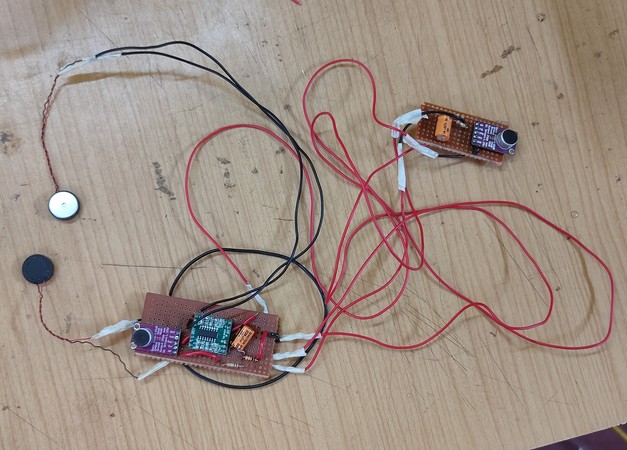
Problem Statement: A device which helps deaf people listen without using in-ear hearing aid. Integrate the technology of bone
conduction inside spectacles so as to keep it subtle.
Proposed Solution: Use a microphone module to captre the sound(input). A Bone Conduction Transducer(output) that will vibrate
the bone near ear and an amplifier for th amplification of the transducers
My Role: I helped the students during these stages:
⇢ Selection of the exact components for the project.
⇢ Figuring out the connection of the component with each other.
⇢ Transfer the circuit from breadboard to Zero PCB, solder the components, and troubleshoot any connection issues.
Tech Stack / Components: MAX9814 analog microphone, PAM8403 analog amplifier, 16mm Mini speaker Bone conuduction,
10K resistor, 180K resistor, 220uf capacitor.
.
Outcome: Working prototype of a bone conduction device which will capture the sound from and vibrate the transducers on the bone
causing the user to listen to the sound.
This project was developed by talents(Higher Secondary) from Innovation school at
Maker's Asylum
and is presented solely to showcase my mentorship in the area of
electronics. All rights to the project are retained by the talents and the institution
Air Quality Monitor
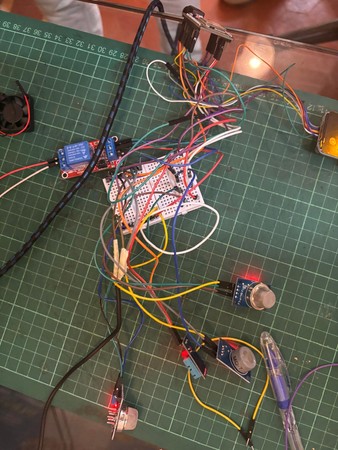
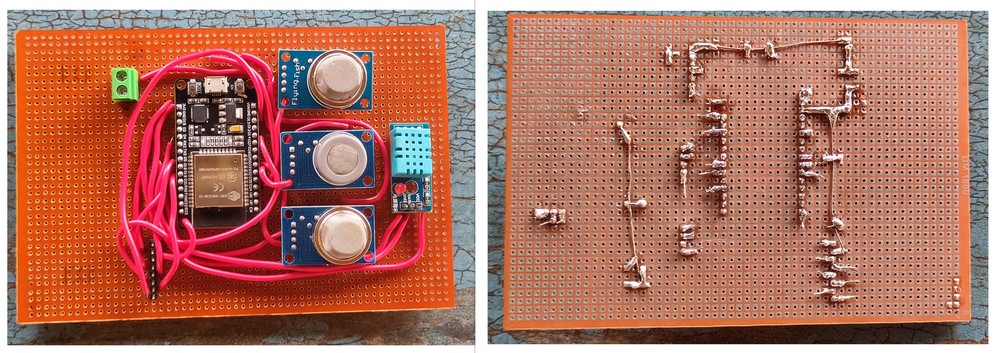
Problem Statement: A device that monitors Air Quality.
Proposed Solution: Use a bunch of sensors from MQ series and temperature sensors(input) to measure air quality and gases
like carbon monoxide, methane etc and display it on a small OLED(output) or send the data on a cloud platform/app.
My Role: I helped the students during these stages:
⇢ Selection of the exact components for the project.
⇢ Figuring out the connection for each component with the microcontroller.
⇢ Interface the component individually with the microcontroller.
⇢ Transfer the circuit from breadboard to Zero PCB, solder the components, and troubleshoot any connection issues.
Tech Stack / Components: MQ2, MQ7, MQ135, DHT11, Waveshare 1.83" LCD, ESP32, Relay.
Outcome: Working prototype of a device which monitors and displays the Air quality on the LCD as well as send the reading
on a cloud plaform. Based on the combination of readings from all sensors, the relay will trigger. One can attach a fan/exhaust on the relay
to fliter/push out the toxic air out of the room.
This project was developed by talents(Higher Secondary) from Innovation school at
Maker's Asylum
and is presented solely to showcase my mentorship in the area of
electronics. All rights to the project are retained by the talents and the institution
Braille Converter
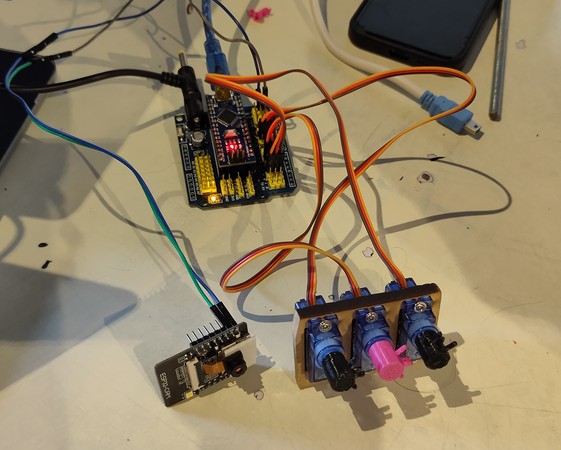
Problem Statement: A wearable device for the blind which would scan the surrounding and convert the texts into braille.
Proposed Solution: Use a ESP CAM module(input) to capture the image, download the captured image onto your PC,
with the help of python libraries like easyocr convert image into text, send the text back to a separate controller and use
servos(output) to actuate the braille.
My Role: I helped the students during these stages:
⇢ Selection of the exact components for the project.
⇢ Interface the component individually.
⇢ Write the python script that captures an image and convert it into text.
Tech Stack / Components: ESP CAM module, Arduino Nano with expansion shield, servos, 12v adaptor.
Outcome: Working proof of concept of device which can capture an image, convert it into text and send the data to the
microcontroller.
This project was developed by talents(Higher Secondary) from Innovation school at
Maker's Asylum
and is presented solely to showcase my mentorship in the area of
electronics. All rights to the project are retained by the talents and the institution
Quadcoper Add-On
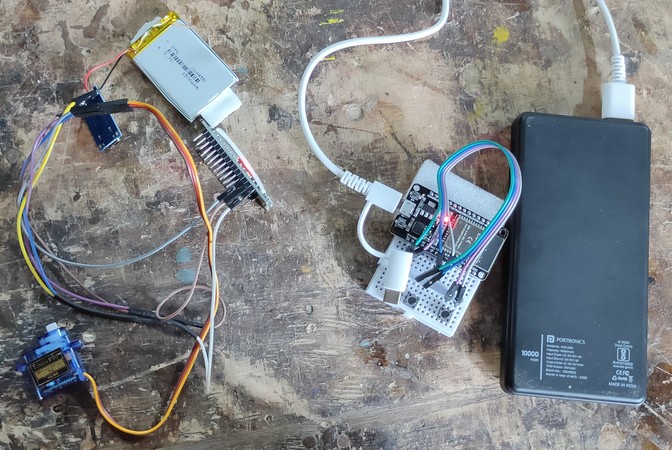
Problem Statement: Mount an add-on onto commercially available quadcopter. The add-on should be able to drop medicines in
inaccessible areas.
Proposed Solution: Use 2 esp32. One esp goes with quadcopter with servo(output) atached onto a case with a flap. Another esp
attaches with the remote of quadcopter with 2 push bottons(input) attached. Use espnow protocol for the communication
My Role: I helped the students during these stages:
⇢ Figuring out the connection for each component with the microcontroller.
⇢ Interface the component individually with the microcontroller.
⇢ Finalize the layman logic on how the project should work.
⇢ Translate the layman logic into programming.
Tech Stack / Components: ESP32, Push button, SG90 servo, 3.7V single cell li-on battery, TP4056 BMS .
Outcome: Working proof of concept of actuating servo onto the quadcopter remotely through esp32.
This project was developed by talents(Higher Secondary) from Innovation school at
Maker's Asylum
and is presented solely to showcase my mentorship in the area of
electronics. All rights to the project are retained by the talents and the institution
Compost Monitor
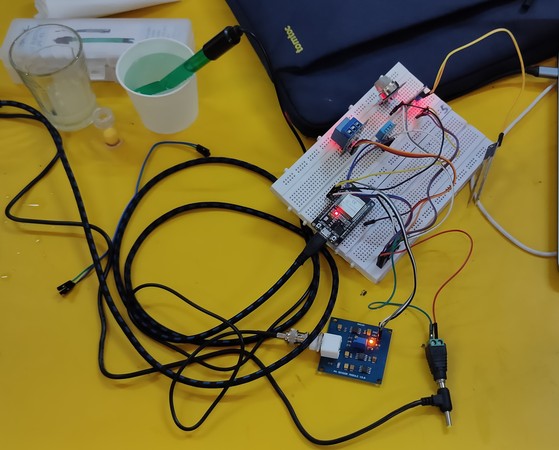
Problem Statement: A device that monitors the state of compost and based on the state of compost, it will start rotating
the compost barrell.
Proposed Solution: Use a bunch of sensors like gas sensor, temperature sensor, soil moisture sensor, pH sensor(input) to
monitor the state of the compost and trigger a relay(output) onto which a motor can be connected to rotate the barrell
My Role: I helped the students during these stages:
⇢ Selection of the exact components for the project.
⇢ Figuring out the connection for each component with the microcontroller.
⇢ Interface the component individually.
Tech Stack / Components: ESP32, MQ135, Soil moisture sensor, DHT11, 5v Single chanel relay, analog pH sensor, 5v power
adaptor, DC female jack adaptor.
Outcome: Working prototype of a device which monitors and sends the data of various sensors to a static HTML page. Based
on the combination of data from the sensors, it will trigger the relay. For the future enhancement, a motor can be attached onto the relay
which would rotate the barrell for composting.
This project was developed by talents(Higher Secondary) from Innovation school at
Maker's Asylum
and is presented solely to showcase my mentorship in the area of
electronics. All rights to the project are retained by the talents and the institution
One Handed Keyboard
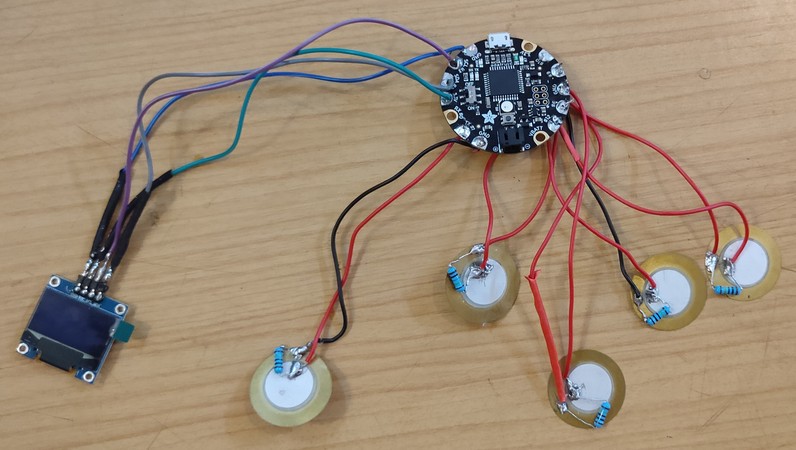
Problem Statement: Make a wearable device that can be worn on one hand and works as a keyboard.
Proposed Solution: Use piezoelectric disks(input) to detect the taps of finger and an OLED display(output) that shows the
transcribed texts. Attach piezo disks on the fingers and thumb. Each piezo can select multiple letters, just like the old keypad phones where
multiple letters were assigned to single button, where you press once for A and press thrice for letter C. So each finger and thumb is assigned
multiple letters. For functions like backspace,
capslock, space use combination of taps like ring finger and middle finger for space and so on.
My Role: I helped the students during these stages:
⇢ Selection of the exact components for the project.
⇢ Figuring out the connection for each component with the microcontroller.
⇢ Interface the component individually with the microcontroller.
⇢ Finalize the layman logic on how the project should work.
⇢ Translate the layman logic into programming.
Tech Stack / Components: Piezoelectric ceraamic disk 35mm, 0.96"OLED, Adafruit Flora board, 10Mohm resistor,
3.7V single cell li-on battery, TP4056 18650 BMS + Booster.
Outcome: Working proof of concept of device which detects taps of the finger and either types letters or apply function like
backspace, capslock etc and dislays the result on the OLED.
This project was developed by talents(Higher Secondary) from Innovation school at
Maker's Asylum
and is presented solely to showcase my mentorship in the area of
electronics. All rights to the project are retained by the talents and the institution
Automatic Plant Watering

Problem Statement: A device that automatically plants the water when the moisture drops.
Proposed Solution: Use a soil moisture and temperature/humidity sensor(input) which senses the moisture level in soild and temp/humidity
in the surrounding. Based on that turn on a DC motor to simulate watering the plant and display the readings on a display module(output)
My Role: I helped the students during these stages:
⇢ Learning basis of electronics: Arduino, breadboard, jumper wires, sensors.
⇢ Selection of components for the project.
⇢ Finalize the layman logic on how the project should work.
⇢ Verifying the connections of the components.
Tech Stack / Components: Capacitive soil moisture sensor, DHT11, 0.96" OLED, 12V DC geared motor, 5V Relay, 9V battery, Arduino UNO.
Outcome: Working proof of concept of device which automatically waters the plant when the moisture level in the soil drops or if humidity of the
surrounding is low.
This project was developed by the PGP (Post graduate MBA) students at
Masters' Union
and is presented solely to showcase my mentorship in the area of
electronics. All rights to the project are retained by the talents and the institution
Smart White Cane

Problem Statement: A white cane that alerts the user if it detects and object or person in close proximity and puddles on the ground.
Proposed Solution: use a proximity sensor to detect objects or person and a water level sensor to detect water in the puddle(input). Use a buzzer
for alerting the user
My Role: I helped the students during these stages:
⇢ Learning basis of electronics: Arduino, breadboard, jumper wires, sensors.
⇢ Selection of components for the project.
⇢ Finalize the layman logic on how the project should work.
⇢ Verifying the connections of the components.
Tech Stack / Components: Ultrasonic sensor, water level sensor, buzzer, 9V battery, Arduino UNO.
Outcome: Working proof of concept of a smart cane that alerts user if it detects a person, object or puddle.
This project was developed by the PGP (Post graduate MBA) students at
Masters' Union
and is presented solely to showcase my mentorship in the area of
electronics. All rights to the project are retained by the talents and the institution
Smart Dustbin
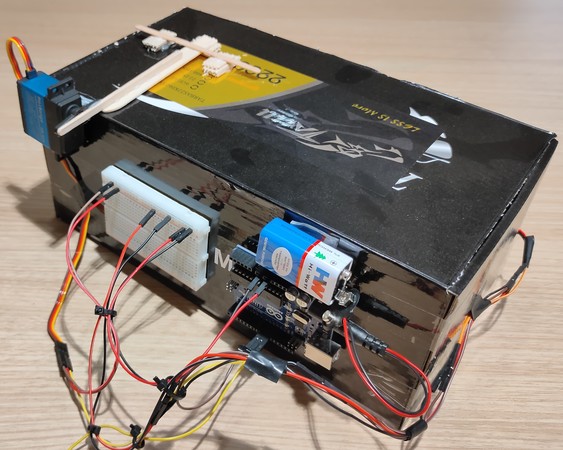
Problem Statement: A dustbin whose lid should automatically open when throwing the trash inside.
Proposed Solution: use a proximity sensor(input) to detect person nearby and a servo motor(output) to open the lid
My Role: I helped the students during these stages:
⇢ Learning basis of electronics: Arduino, breadboard, jumper wires, sensors.
⇢ Selection of components for the project.
⇢ Finalize the layman logic on how the project should work.
⇢ Verifying the connections of the components.
Tech Stack / Components: Ultrasonic sensor, servo motor, 9V battery, Arduino UNO.
Outcome: Working proof of concept of a smart dustbin whose lid will open when a person is nearby to throw the garbage.
This project was developed by the PGP (Post graduate MBA) students at
Masters' Union
and is presented solely to showcase my mentorship in the area of
electronics. All rights to the project are retained by the talents and the institution
Toll Booth
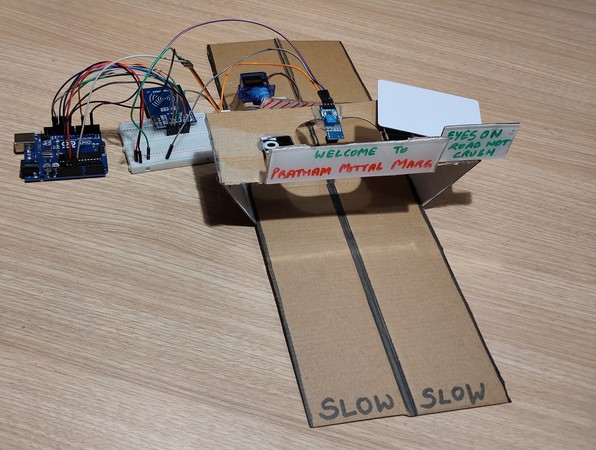
Problem Statement: A toll booth whose boom barrier will open when FasTAG like card is scanned.
Proposed Solution: use an RFID module(input) to scan the RFID cards and a servo(output) to simulate the boom barrier
My Role: I helped the students during these stages:
⇢ Learning basis of electronics: Arduino, breadboard, jumper wires, sensors.
⇢ Selection of components for the project.
⇢ Finalize the layman logic on how the project should work.
⇢ Verifying the connections of the components.
Tech Stack / Components: RC522 RFID module, servo motor, IR sensor, Arduino UNO.
Outcome: Working proof of concept of a boom barrier which only opens when it detects a car and an RFID card .
This project was developed by the PGP (Post graduate MBA) students at
Masters' Union
and is presented solely to showcase my mentorship in the area of
electronics. All rights to the project are retained by the talents and the institution